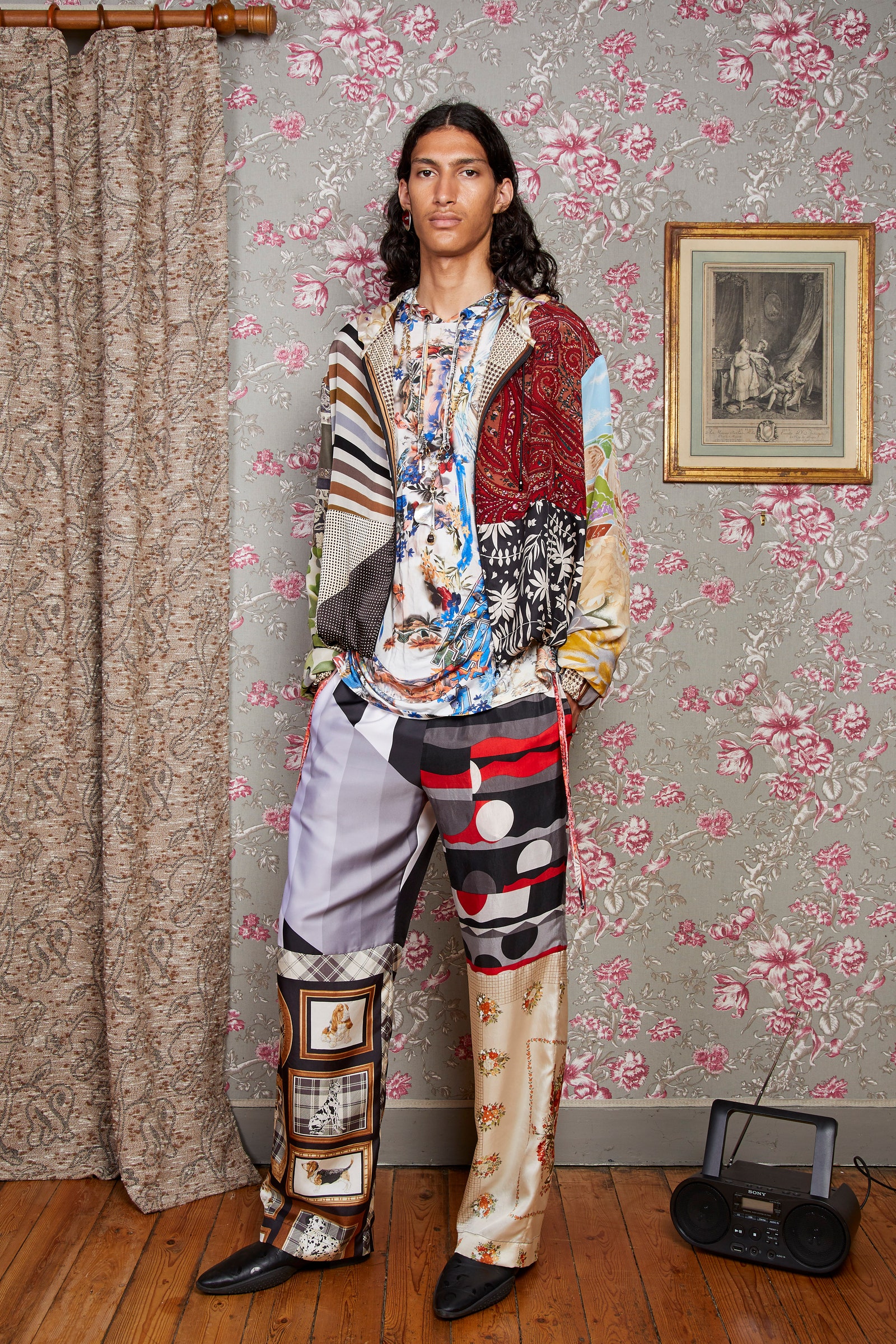Serre first came to love clothing through collecting vintage, and you can see that adoration for 1950s couture shapes and suiting in her early collections, though that’s felt less present in
her last two shows. This collection, with exquisite coats and big linen bowling shirts and men’s skirts, seemed to reanimate those ideas and yank them forward into something somehow both real and glamorous.
Serre is the rare designer whose collections begin from what is available to her rather than what she dreams up—she starts with the deadstock materials in her warehouse and enters a simultaneous state of reverie and problem-solving. Here, the source materials on hand included a popcorn fabric—the tiny novelty fabric that stretches over the body—as well as the torchon towels used by French chefs. Her recycled denim is back in dusty cherry tones.
If the torchon suiting and recycled silks have the cool factor Serre has cultivated, the most powerful section is a group of extraordinarily beautiful white pieces made from embroidered linen tablecloths and tea towels; there are also necklaces and bracelets made from spoons and forks. “It’s a lot about care,” she said of the collection and film. “Care about other people, care about yourself, cooking. I’m also emphasizing again, [as in] Core, how simple things have importance in life. I’m often making this link between the fashion industry and food industry.”
Indeed, the parallel between fashion and food is one she’s considered a lot—it wasn’t our first time discussing it, and I’d been turning it over in my head for days before I talked to the designer, incidentally. Over the past two decades, the food industry has undergone an existential awakening in which even the most passive consumer became aware of the benefits of organic produce, the hazards of processed foods, and the pleasures of cooking. It's an appealing model for the fashion industry.
We’d like to think this was a shift in faith or consciousness—that consumers became more health conscious, more aware of the impact the food industry has on the environment. But it seems to me that this was as much an aesthetic revolution as an ethical one. Celebrity chefs like Anthony Bourdain used their charisma to make us more aware of a global palate of food, and cookbook authors like Samrin Nosrat and writers like Michael Pollan helped us understand pleasure in new ways as much as they elucidated the political and environmental issues of the food industry. (Food, much more successfully than fashion, has also started to reckon with “toxic workplaces” in the kitchen.) These were ways that were friendly to Instagram, to our bookshelves, to our eyes and most of all to our sense of taste. This was ultimately, you might say, a revelation propelled forward by beauty.
That’s what’s so special about Serre’s work, and what this collection embodied so well. First of all, while she remains heavily influenced by designers like Martin Margiela (who upcycled before that was an act of sustainable design) and Jean-Paul Gaultier, in her globalist view, she has invented her own supremely original concept of beauty. (This collection, which is true to her aesthetic but filled with mature clothes, makes little use of her signature moon print. That is the right choice commercially, since the viral moon pieces have become so popular that they’re now knocked off by the fast fashion brands Serre’s business exists in contrast to.) Her clothing feels as much heavy metal and kinda goth and very gnarly, as it does lovely, with these well dressed, elegantly tattooed humans in a breathtaking country house tucking into squid-ink pasta ortolan-bunting style, linen napkins draped over their heads. The printed pieces of this collection—which aren’t upcycled, but are instead ecologically certified viscose and jersey, per a certificate supplied by Serre’s team—combine familiar imagery from past Serre collections into pajama-like suits. The man who wears Serre—and menswear is now basically an equal part of her offering—looks otherworldly and genteel.
With this collection, Serre nailed a mix of fashion-head realness and trend-averse sophistication. It may be that to create change, one has to create beauty, for better or for worse.
To my mind, that’s for the best—our world has just been too, too ugly over the past decade or so. I don’t even mean spiritually; I mean everything is too big, too obvious, too often created or borne out of fear or negativity. When I asked whether she was feeling optimistic, she nodded a bit hesitantly. “I think maybe, yes, I have something more positive, or a little bit more hope than I did four years ago, when I started,” she said. “Somehow, this proposition of a new world is now followed by more people than just three years ago.” She doesn’t just mean the success of her brand—“I mean with the young generation changing the world.”
“I’ve always been what you are seeing today,” she said. “It’s just that it was not the right moment.”

